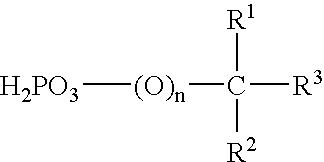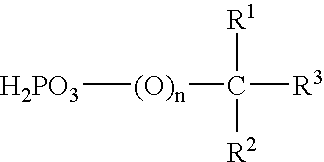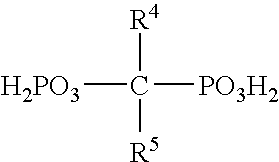Negative Working, Heat-Sensitive, Lithographic Printing Plate Precursor
a technology of lithographic printing plate and precursor, which is applied in the direction of lithography, photosensitive materials, instruments, etc., can solve the problems of toning at the non-image areas, surface of the printing plate precursor showing so-called point defects, and containing non-image areas
- Summary
- Abstract
- Description
- Claims
- Application Information
AI Technical Summary
Benefits of technology
Problems solved by technology
Method used
Image
Examples
example 1
1) Preparation of the Lithographic Support
[0072]A 0.30 mm thick aluminum foil was degreased by immersing the foil in an aqueous solution containing 40 g / l of sodium hydroxide at 60° C. for 8 seconds and rinsed with demineralized water for 2 seconds. The foil was then electrochemically grained during 15 seconds using an alternating current in an aqueous solution containing 12 g / l of hydrochloric acid and 38 g / l of aluminum sulfate (18-hydrate) at a temperature of 33° C. and a current density of 130 A / dm2. After rinsing with demineralized water for 2 seconds, the aluminum foil was then desmutted by etching with an aqueous solution containing 155 g / l of sulfuric acid at 70° C. for 4 seconds and rinsed with demineralized water at 25° C. for 2 seconds. The foil was subsequently subjected to anodic oxidation during 13 seconds in an aqueous solution containing 155 g / l of sulfuric acid at a temperature of 45° C. and a current density of 22 A / dm2, then washed with demineralized water for 2 s...
example 2
1) Preparation of the Lithographic Support
[0083]The support was prepared as in Example 1.
2) Preparation of the Printing Plate Precursor
[0084]The printing plate precursors PPP-6 to PPP-10 were produced by applying a coating onto the above described lithographic support. The coating was applied from an aqueous coating solution, dried and the layer thus obtained had a composition as defined in Table 3. Before coating, the pH of the coating solution was adjusted to 3.5.
TABLE 3composition of the dry coating(mg / m2).INGREDIENTSPPP-6PPP-7PPP-8PPP-9PPP-10mg / m2Ref.Inv.Inv.Inv.Inv.Styrene / Acrylonitrile646.8646.8646.8646.8646.8copolymer (1)Cab O Jet 250 (2)42.042.042.042.042.0Triethylammonium salt84.084.084.084.084.0of IR-1 (3)Polyacrylic acid84.084.084.084.084.0binder (4)Zonyl FSO 100 (5)7.57.57.57.57.5Dequest 2010 (6)—15.130.245.460.5(1) weight ratio 60 / 40, stabilized with an anionic wetting agent; average particle size of 50 nm, measured with a PL-PSDA Particle Size Distribution Analyzer, co...
example 3
1) Preparation of the Lithographic Support
[0088]The support was prepared as in Example 1.
2) Preparation of the Printing Plate Precursors
[0089]The printing plate precursors PPP-11 to PPP-14 were produced by applying a coating onto the above described lithographic support. The coating was applied from an aqueous coating solution, dried and the layer thus obtained had a composition as defined in Table 5. Before coating, the pH of the coating solution was adjusted to 3.6.
TABLE 5composition of the dry coating(mg / m2).INGREDIENTSPPP-11PPP-12PPP-13PPP-14mg / m2Ref.Inv.Inv.Inv.Styrene / Acrylonitrile648.6—648.6—copolymer (1)Styrene / Acrylonitrile—648.6—648.6copolymer (2)Heliogen Blau D7490 (3)75.675.675.675.6Triethylammonium salt of IR-1 (4)84.084.084.084.0Polyacrylic acid binder (5)84.084.084.084.0Zonyl FSO 100 (6)7.57.57.57.5Dequest 2010 (7)151.2151.2419.4419.4(1) weight ratio 50 / 50, stabilized with sodium dodecyl sulphonate; average particle size of 49 nm, measured with a Brookhaven BI-90 anal...
PUM
| Property | Measurement | Unit |
|---|---|---|
| Percent by mass | aaaaa | aaaaa |
| Percent by mass | aaaaa | aaaaa |
| Nanoscale particle size | aaaaa | aaaaa |
Abstract
Description
Claims
Application Information
 Login to View More
Login to View More - R&D
- Intellectual Property
- Life Sciences
- Materials
- Tech Scout
- Unparalleled Data Quality
- Higher Quality Content
- 60% Fewer Hallucinations
Browse by: Latest US Patents, China's latest patents, Technical Efficacy Thesaurus, Application Domain, Technology Topic, Popular Technical Reports.
© 2025 PatSnap. All rights reserved.Legal|Privacy policy|Modern Slavery Act Transparency Statement|Sitemap|About US| Contact US: help@patsnap.com



